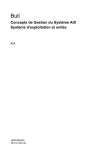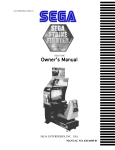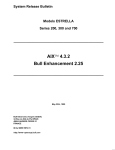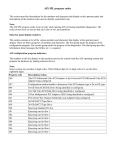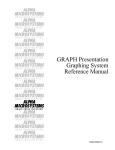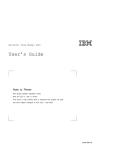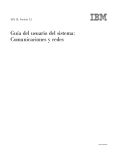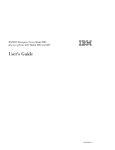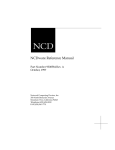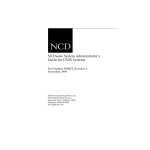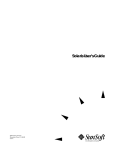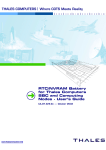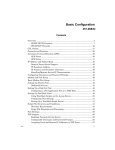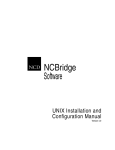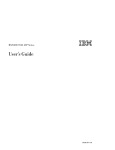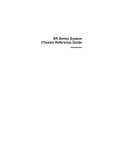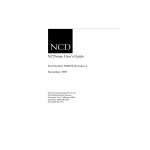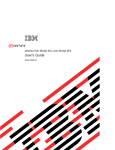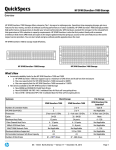Download AIX Version 4.2 Release Notes
Transcript
AIX Version 4.2 Release Notes Software Release AIX 4.2.0r1 Part Number AX2RNA/IS1 Eighth Edition (May 1997) This edition of Release Notes applies to AIX 4.2 and to all subsequent releases of this product until otherwise indicated in new releases or technical newsletters. THIS MANUAL IS PROVIDED “AS IS” WITHOUT WARRANTY OF ANY KIND, EITHER EXPRESS OR IMPLIED, INCLUDING, BUT NOT LIMITED TO, THE IMPLIED WARRANTIES OF MERCHANTABILITY AND FITNESS FOR A PARTICULAR PURPOSE. The laws of some states and countries do not allow the disclaimer of express or implied warranties in certain transactions; therefore, this statement may not apply to you. As such, the above warranty disclaimer shall only apply to the extent permitted by law. While reasonable efforts have been made to assure the accuracy of this document, Motorola, Inc. assumes no liability resulting from any omissions in this document, or from the use of the information obtained therein. It is not warranted that the contents of this publication or the accompanying source code examples, whether individually or as one or more groups, will meet your requirements or that the publication or the accompanying source code examples are error-free. This publication could include technical inaccuracies or typographical errors. Motorola reserves the right to revise this document and to make changes from time to time in the content hereof without obligation of Motorola to notify any person of such revision or changes It is possible that this publication may contain references to, or information about Motorola products (machines and programs), programming or services that are not announced or released in your country or region. Such references or information may not be construed for any purpose to mean that Motorola intends to announce or release such products, programming or services in your country or region. Any reference to a licensed program in this publication is not intended to state or imply that you can use only that licensed program. You can use any functionally equivalent program instead. No part of this material may be reproduced or copied in any tangible medium, or stored in a retrieval system, or transmitted in any form, or by any means, radio, electronic, mechanical, photocopying, recording or facsimile, or otherwise, without the prior written permission of Motorola, Inc. If the documentation contained herein is supplied, directly or indirectly, to the U.S. Government, the documentation is provided only as “restricted computer software” as defined in FAR 52.227-19 Commercial Computer Software--Restricted Rights. © COPYRIGHT MOTOROLA, INC. 1997. ALL RIGHTS RESERVED. Printed in the United States of America. © Copyright International Business Machines Corporation 1994. All rights reserved. iv Contents CHAPTER 1 Introduction About This Guide....................................................................................................... 1-1 Purpose .................................................................................................................. 1-1 Scope ..................................................................................................................... 1-1 Prerequisites......................................................................................................... 1-1 Getting Help for System Problems .......................................................................... 1-2 CHAPTER 2 Features Overview ..................................................................................................................... 2-1 What’s New in this Release ...................................................................................... 2-2 Motorola Value-Added Features.............................................................................. 2-4 xdiff Utility Available ......................................................................................... 2-4 Environmental Monitor Commands................................................................ 2-4 Environmental Monitor Special Files (Devices) ............................................. 2-5 CHAPTER 3 Guidelines Overview ..................................................................................................................... 3-1 Installation................................................................................................................... 3-2 AIX Version 4.2 Shipped on Four CD-ROM Disks......................................... 3-2 Migrating to AIX Version 4.2 from a Version of AIX 4.1 ............................... 3-2 Required Firmware Upgrade for VME Systems............................................. 3-2 AIX Common Desktop Environment 1.0......................................................... 3-2 For Customers Moving to AIX CDE 1.0 from Any Version of AIX 4.1 ....... 3-3 Running the AIX Common Desktop Environment........................................ 3-4 Network Boot Support ....................................................................................... 3-4 Ultimedia Services and UIM/X ........................................................................ 3-5 Graphics Licensed Programs............................................................................. 3-5 AIX Network Install Manager (NIM) README............................................ 3-5 SystemView License Use Management Runtime........................................... 3-5 7135 RAIDiant Array for AIX............................................................................ 3-6 Installing NetWare .............................................................................................. 3-6 AIX 4.1 Customized InfoExplorer Files are Overwritten.............................. 3-7 Using sendmail Version 5.64 on AIX 4.2.......................................................... 3-7 Using the sendmail Version 8.7 .forward File ................................................. 3-8 v Node-locked Licenses Unavailable for Some Products .................................3-9 IRQs 14 and 15 Available for Plug-In ISA Cards ............................................3-9 Installing a PCI Expansion Chassis on a PowerStack II Series EX System ..........................................................................................................3-11 Multiple Beep Volume Settings Not Supported............................................3-11 Base Operating System ............................................................................................3-12 getattr() Routine Does Not Release Memory.................................................3-12 Changing tty Port Attributes—chdev Command.........................................3-12 Ensuring Sufficient Disk Space in /var/dt....................................................3-12 Common Desktop Environment (CDE) Manual Pages Directory Not in MANPATH.............................................................................................3-12 Adding Internal Loopback Functionality ......................................................3-13 National Language Support....................................................................................3-14 Chinese (Simplified) Keyboard Translate Table ............................................3-14 Chinese (Simplified) Input Method Support.................................................3-14 Error Logging with errpt Command ..............................................................3-14 Optional Software.....................................................................................................3-15 Viewing Information about Optional Software ............................................3-15 Graphics .....................................................................................................................3-16 Starting the X Server on Machines with Planar Graphics Capabilities ........................................................................................................3-16 Serial Dials/LPFKeys Support ........................................................................3-16 CHAPTER 4 Known Problems Overview......................................................................................................................4-1 Memory Leak Exists in Motif Version 1.2.3 ............................................................4-2 Tracking Number.................................................................................................4-2 Problem .................................................................................................................4-2 Workaround..........................................................................................................4-2 SMIT Erase Methods Inconsistent............................................................................4-3 Tracking Number.................................................................................................4-3 Problem .................................................................................................................4-3 Workaround..........................................................................................................4-3 POSIX Compliance Testing Suite Failures...............................................................4-4 Tracking Number.................................................................................................4-4 Problem .................................................................................................................4-4 Highest Resolution Not Available on Systems with 1MB Display Memory for Cirrus Adapters ....................................................................................4-5 Tracking Number.................................................................................................4-5 Problem .................................................................................................................4-5 vi Workaround......................................................................................................... 4-5 Floppy Drives Do Not Detect Disk Density ........................................................... 4-6 Tracking Number ................................................................................................ 4-6 Problem ................................................................................................................ 4-6 Workaround:........................................................................................................ 4-6 System Boot Appears to Halt with stop timed out error...................................... 4-7 Tracking Number ................................................................................................ 4-7 Problem ................................................................................................................ 4-7 Workaround......................................................................................................... 4-7 Uniprocessor Floating Point Interrupt Problem .................................................... 4-9 Tracking Number ................................................................................................ 4-9 Problem ................................................................................................................ 4-9 Workaround:........................................................................................................ 4-9 Known Problems Filed with the Vendor .............................................................. 4-10 CHAPTER 5 Documentation Changes Overview ..................................................................................................................... 5-1 Location of schedtune Command Incorrect in InfoExplorer Libraries .............. 5-2 xmemout() Man Page Incorrect................................................................................ 5-3 AIX Version 4 Installing and Configuring NCDware ........................................... 5-4 AIX Version 4 System Management Guide: Communications and Network....................................................................................................................... 5-5 Configuring NIS Documentation Error .................................................................. 5-6 AIX Version 4 Commands Reference ...................................................................... 5-7 AIX Version 4 AIXwindows Programming Guide................................................ 5-8 vii viii List of Tables TABLES Table 3-1. Table 4-1. PCI Interrupt Routing on Systems with ISA Slots .......................... 3-9 TARs Filed with IBM ......................................................................... 4-10 ix x 1Introduction 1 About This Guide Purpose The AIX 4.2 Software Release Notes contains information on the functionality of the AIX 4.2.0r1 product. Scope The AIX 4.2 Release Notes contains information on: • new or changed features for this release of the AIX 4.2 operating system • value-added features of Motorola’s AIX 4.2 operating system • general notes about AIX 4.2 • known problems in this release of the operating system • changes and corrections to documents in the AIX 4.2 product library Prerequisites Some instructions in this guide assume that you are familiar with: • AIX system administration commands • System Management Interface Tool (SMIT) For more information about these concepts, refer to the AIX Version 4.2 System Management Guide: Operating System and Devices. Use this guide in conjunction with the AIX 4.2 Installation Guide and the AIX 4.2 Quick Installation Guide. 1-1 1 Getting Help for System Problems If you encounter difficulties with AIX 4.2 on your system or on a supported board, contact your Value Added Reseller (VAR) or distributor first. If further assistance is needed, you can contact the Motorola Computer Group Sales office or Motorola Computer Group’s customer support group at: • U.S.A. 1-800-551-1016 • Canada 1-800-387-2416 • Maidenhead, U.K. 44-1628-39121 • Paris, France 33-1-467-43560 • Duesseldorf, Germany 49-211-65899-55 When you call, please be prepared to provide the following information: • the type of system (Series E, Series RISC PC, or RISC PC Plus) or motherboard (MVME, Ultra, Atlas, or XR Series) you are using with AIX 4.2 • your system or board ID or serial number • the name of your company, your name, and a telephone number • a brief description of the problem, including the severity of its impact on your ongoing efforts This information will be forwarded to the appropriate technical engineering contact, who will return your call promptly. 1-2 Getting Help for System Problems 2Features 2 Overview This chapter describes new and changed features of the AIX 4.2 environment, as well as Motorola value-add features. For more information about standard features in AIX 4.2, refer to the AIX 4.2 Product Description. 2-1 2 What’s New in this Release The following new features have been implemented in AIX 4.2: Newly Supported Hardware • support for MVME332XT asynchronous controller • support for PMC cards on MVME130x boards • support for Formation PCI cards • support for RNS FDDI adapters • 4-slot PCI-PCI card for PowerStack II Pro 4000 • support for the MVME376 adapter Changes to Storage Management • Larger data files allowed (to 64 GB) • Larger executables (2 GB for data section, 256MB for code) • Larger file systems and devices (1 terabyte) • NFS remains V2 (max file size 2GB) • Merging of LVM and CLVM • Disk sharing between systems Changes to Communication Features • Enhanced Network Environment • NTP - Network Time Protocol Version 3 (RFC 1305) Changes that affect programmers and users • Enhanced Common Desktop Environment • Graphical workspace manager • API for dynamic loading of program objects • Shared Library enhancements 2-2 What’s New in this Release • 604 specification 2 Other Features • Asynchronous communication support enhancements • Year 2000 enablement - 4 digit date fields ISO 8601 • Additional National language support • Printing to generic third-party asynchronous adapters supported • X Server Enhancements Packaging Two CD-ROMs for base OS Two Bonus CD-ROMs: • Java • Adobe Acrobat Reader 2.1 • Ultimedia Services for AIX Version 2.1.4 • Netscape Navigator, Version 3.0 • Netscape FastTrack Server • Internet Connection Secure Server for AIX Features 2-3 2 Motorola Value-Added Features The AIX 4.2 product is based on IBM’s AIX 4.2 operating system. Minimal changes have been made to this product to support Motorola-specific hardware platforms. This section describes value-added features that are specific to all systems running Motorola’s version of the AIX 4.2 operating system. xdiff Utility Available The xdiff program is available in AIX 4.2 Service Level AOS1.2 and later releases. xdiff is a graphical interface to the diff command that allows side-by-side viewing of differences between files and automated merging of selected differences to create a new version of a file. xdiff is automatically installed with the Personal Productivity bundle. Alternatively, you can install it directly from the X11.apps.motorola fileset. Environmental Monitor Commands The following commands have been added to Motorola’s AIX 4.2 operating system and are documented in the manual pages in section 1M. These commands are used with the environmental monitor and are supported on all systems except RISC PC (and RISC PC Plus) systems: • envctl • envdiag • rc.motpowerfail You must use the man command to access these manual pages; they are not available through InfoExplorer. 2-4 Motorola Value-Added Features Environmental Monitor Special Files (Devices) 2 The following manual pages have been added to the manual pages section 7 on Motorola’s AIX 4.2 operating system. These pages describe aspects of environmental monitor special files (devices) and are supported on all systems except RISC PC (and RISC PC Plus) systems: • envmon • envmon_msg • envmon_odm You must use the man command to access these manual pages; they are not available through InfoExplorer. Features 2-5 2 2-6 Motorola Value-Added Features 3Guidelines 3 Overview This section contains information about and guidelines for the AIX 4.2 operating system. 3-1 Installation 3 AIX Version 4.2 Shipped on Four CD-ROM Disks AIX 4.2 is shipped on multiple media. If you are using CD-ROM when migrating from a previous release of AIX to Version 4.2, important instructions are provided in the AIX 4.2 Installation Guide. Migrating to AIX Version 4.2 from a Version of AIX 4.1 Migrations to AIX 4.2 are available for systems which are currently running Version AOS 1.3 and later. For information on how to migrate your system from a version of the AIX 4.1 operating system, refer to the Installation Guide. Note: It is possible, but unlikely, that problems which were fixed by PTF in AIX 4.1 will recur in 4.2.0. If so, contact your Value Added Reseller or distributor to see if an appropriate 4.2.0 PTF is available. Required Firmware Upgrade for VME Systems If you are upgrading a VME system from an earlier version of AIX 4.1 to AIX 4.1.5r1, you must upgrade your firmware to PPC1BUG version. 3.0. AIX Common Desktop Environment 1.0 This section provides information on moving to the AIX Common Desktop Environment (CDE) 1.0 from any version of AIX 4.1. Notes: 1. AIX Common Desktop Environment (AIX CDE) is the default desktop shipped with AIX 4.1.3 or higher. 2. AIXwindows Desktop is the default desktop shipped with AIX 3.2.x, 4.1.0, 4.1.1 and 4.1.2. 3-2 Installation An on-line help volume is provided to assist you in migrating to AIX CDE 1.0 from the AIX windows Desktop. This help will be displayed automatically the first time you log onto AIX CDE 1.0 if you have previously logged onto the AIXwindows desktop on AIX 4.1.0, 4.1.1 or 4.1.2. You can also view this on-line help by selecting “Welcome to AIX CDE 1.0 from the Help Manager subpanel. Note: A minimum of 64MB of paging space is required to run AIX CDE. For Customers Moving to AIX CDE 1.0 from Any Version of AIX 4.1 Some changes have been made to action, data type and front panel definitions between AIX 4.1.0, 4.1.1 or 4.1.2 and this release of AIX. Therefore, the following list provides options for customers moving to AIX CDE 1.0 from any version of AIX 4.1: • If you have not made any customizations to your desktop, if you do not have your home directory out in a networked environment, and if you do not mount a file system containing action, data type and front panel definition files, you do not need to make any changes. The X11.Dt.compat fileset should be installed to aid in the transition from AIXwindows Desktop on AIX 4.1 to the AIX CDE 1.0 desktop. This fileset contains executables, icons, action and data type definitions and symbolic links to maintain compatibility with previous versions of the CDE desktop. This fileset also contains the Migrate Actions icon and its associated action definition. The “Welcome to AIX CDE 1.0” help volume contains additional information the contents of this fileset. This fileset can be deinstalled later when you no longer have a need for the files contained within it. • If you have made customizations to your desktop action and data type definition file (*.dt) or to your front panel definition files (*.fp) or installed icons on the front panel, you need to Guidelines 3-3 3 migrate these changes to the new desktop using Migrate Actions (dtmigrate). To start dtmigrate: 3 1. Click the Application Manager control from the Front Panel 2. Click the Desktop_Tools icon 3. Click the Migrate Actions icon • If you have customized your desktop actions, data types or front panel, or are planning on running the desktop with file systems that contain action, data type or front panel definitions and the Calendar resource file (.desksetdefaults) shared between an AIXwindows Desktop on AIX 4.1.1 or 4.1.2 and an AIX Common Desktop Environment on AIX 4.1.3 or higher you must take special action. See the “Welcome to AIX CDE 1.0” help for details. Running the AIX Common Desktop Environment If, after migrating to AIX CDE 1.0 from AIXwindows desktop on AOS1.0 or AOS1.1 you have problems with the desktop (for example, icons on the front panel do not execute properly, icons are missing, or actions can not be found), check that the following has been done: 1. The X11.Dt.compat fileset has been installed. 2. Action, data type and front panel definitions in personal directories have been migrated to a valid format for AIX CDE 1.0. The “Welcome to AIX CDE 1.0” help volume contains information about these steps and other useful information to aid in the transition to AIX CDE 1.0. Network Boot Support Network boot is only supported on integrated ethernet controllers and on DEC 2104x and 2114x-based PCI ethernet cards. 3-4 Installation Ultimedia Services and UIM/X Ultimedia Services and UIM/X users upgrading from AIX AOS1.1 or earlier to AIX Version 4.2 also need to upgrade to the following levels of UMS and/or UIM/X: • Ultimedia Services Version 2.1.4 or later Ultimedia Services is available as part of both the AIX 4.2 Bonus Pack for Entry Clients and the AIX 4.2 Bonus Pack for Workgroups, Connections, Entry Server and Advanced Servers. Graphics Licensed Programs Users of these graphics licensed programs will need to upgrade to the following levels when migrating to AIX 4.2: • IBM PEX and PHIGS Programming Interfaces Version 4.2 for AIX (5765-660) • OpenGL 1.0 and GL 3.2 for AIX 4.2 (5765-659) AIX Network Install Manager (NIM) README The AIX Network Install Manager (NIM) includes a README file that is installed with the NIM Master bos.sysmgt.nim.master fileset. The pathname of the file is /usr.lpp/bos.sysmgt/nim/README. The README file contains additional information about the AIX Version 4.2 NIM product. SystemView License Use Management Runtime Some of the products included in this release have been modified to use the license management software. These products require a license password in order for you to use them. SystemView License Use Management Runtime for AIX is the new license management product. It is an enhancement of iFOR/LS included in AIX 4.1. and contains new license management functions, but still uses the same Guidelines 3-5 3 techniques and is completely compatible with iFOR/LS. For further information on SystemView license Use Management Runtime see Using SystemView License Use Management Runtime for AIX . 3 7135 RAIDiant Array for AIX Required 7135-110 Microcode Update: Customers upgrading systems with attached 7135-110 Radiant Array subsystems to AIX 4.2 must also obtain and install the latest version of controller and drive microcode. This microcode update can be obtained via hardware service channels (800-IBM-SERV in the U.S.) by requesting ECA 005. A new publication for the 7135, containing information on microcode and device driver installation, should also be ordered. This publication is titled 7135 Radiant Array for AIX: Installation Guide and Reference, SC23-1742. Creating or Modifying a 7135 LUN: When creating or modifying a LUN IBM does not recommend setting the Reserve Lock field to NO in a multiple host environment. Setting the Reserve Lock field to NO in a multiple host environment can expose the system to file corruption unless an application exists to coordinate access to the shared disk. Installing NetWare When installing NetWare for AIX on your system using a language other than English, do the following: 1. Type ‘local’ at the system prompt. 2. Note the value of the LC_ALL variable. 3. Set the LC_ALL variable to en_US using the command: export LC_ALL=en_US 4. Install NetWare 5. After installing NetWare, reset the LC_ALL variable to the original value noted in step 2. 3-6 Installation AIX 4.1 Customized InfoExplorer Files are Overwritten When migrating to AIX 4.2 from AIX 4.1, the InfoExplorer files under /usr/lpp/info/data are overwritten with AIX 4.2 versions. If you have made customizations to the InfoExplorer configuration files, such as /usr/lpp/info/data/ispaths, you should backup the customized files before starting the migration and merge your changes into the AIX Version 4.2 files after the migration is complete. Using sendmail Version 5.64 on AIX 4.2 Sendmail Version 5.64 (supported on AIX 3.2 and 4.1) and sendmail Version 8.7 (supported on AIX 4.2 or later) are not compatible. UCB sendmail version 8.7 will not work with the Version 5.64 /etc/sendmail.cf file. There is no script available to assist in migration of the Version 5.64 /etc/sendmail.cf file to the Version 8.7 /etc/sendmail.cf file. During migration installation of AIX 4.2, the Version 5.64 sendmail files are saved in the following locations: /usr/lpp/save.config/usr/sbin/sendmail /usr/lpp/save.config/etc/sendmail.cf /lpp/save.config/etc/sendmail.nl The /etc/aliases file was not modified during the installation. Although sendmail Version 5.64 is not supported on AIX 4.2, if you have made complex changes to your previous sendmail configuration and cannot immediately merge those changes into the sendmail Version 8.7 files, you can use the following procedure to copy the saved sendmail Version 5.64 files for temporary use on AIX 4.2. You must replace all the above files. The sendmail Version 8.7 and 5.64 files will not interoperate. Use these instructions to revert to sendmail Version 5.64: 1. Login as root 2. Stop sendmail using the command: Guidelines 3-7 3 stopsrc -s sendmail 3. Save the existing sendmail files: cp -p /usr/sbin/sendmail /usr/sbin/sendmail.orig cp -p /etc/sendmail.cf /etc/sendmail.cf.orig cp -p /etc/sendmail.nl /etc/sendmail.nl.orig 3 4. Restore the sendmail Version 5.64 files using the commands: cp /usr/lpp/save.config/usr/sbin/sendmail /usr/sbin/sendmail cp /usr/lpp/save.config/etc/sendmail.cf /etc/sendmail.cf cp /lpp/save.config/etc/sendmail.nl /etc/sendmail.nl 5. Restart sendmail using the command: startsrc -s sendmail -a “-bd -q30m” Using the sendmail Version 8.7 .forward File Sendmail has been updated on AIX 4.2 to UCB Version 8.7. Please note that the use of the \ (backslash) in the $HOME/.forward files has changed from the previous UCB version. If you are defining local users in a file defined by class L in the /etc/sendmail.cf file, then you no longer need to specify a \ (backslash) in front of the user name in your $HOME/.forward file. The backslash is now interpreted as part of the username. This only applies if you have defined local users in a file specified in class L in the /etc/sendmail.cf file. 3-8 Installation Node-locked Licenses Unavailable for Some Products The AIX 4.1 iFOR/LS System Management Guide and AIX 4.1 iFOR/LS Tips and Techniques include information about and references to nodelocked licenses. However, node-locked licenses are not available for some products that are NetLS license-enabled. Only concurrent access licenses are generated for these products. Motorola products that this affects are: • C for AIX • C Set ++ • XL FORTRAN • XL Pascal • Configuration Management Version Control (CMVC) • IBM Cobol You must use a concurrent access license with the above products, meaning that you need a server package rather than a client package. IRQs 14 and 15 Available for Plug-In ISA Cards Commercial System Desktops and Servers have four PCI interrupt lines. Each line can be independently routed to an interrupt line on the system interrupt controller. PCI interrupt lines on systems with ISA slots are routed as follows: Table 3-1. PCI Interrupt Routing on Systems with ISA Slots Interrupt Line PIRQ0 PIRQ1 PIRQ2 PIRQ3 Guidelines Routed to IRQ 9 9 11 11 3-9 3 This makes IRQs 14 and 15 available for use by plug-in ISA cards (as well as IRQ 5 and IRQ 7, which have always been available). Note 3 This information applies only to systems with ISA slots. The above settings are the default settings, programmed by the firmware. To modify this mapping on a system running PPCBug firmware, use the env command at the PPC1-Diag firmware prompt to change the PCI Interrupts Route Control Registers environment variable. For more information, refer to the PPCBug Firmware Package User’s Manual, Part 1 of 2. To modify this mapping on a system running PowerPC Open Firmware, you can use the setenv command at the ok firmware prompt to change the pirq-route environment variable. For information on how to access the ok prompt, refer to the Open Firmware User’s Manual. To change the pirq-route variable, enter the following command at the ok prompt: setenv pirq-route 0xddccbbaa where dd, cc, bb, and aa correspond to the two-digit hexadecimal equivalents of the IRQs for PIRQ3, PIRQ2, PIRQ1, and PIRQ0, respectively. (Note the inverse order of the IRQs specified.) For example, to route PIRQ0, PIRQ1, PIRQ2, and PIRQ3 to IRQs 5, 9, 14, and 11, respectively, you would enter the following command at the PPCOF ok prompt: setenv pirq-route 0x0B0E0905 To revert to the default mapping after the pirq-route variable has been added, enter the following command at the ok prompt to remove the pirq-route variable: unset pirq-route 3-10 Installation Installing a PCI Expansion Chassis on a PowerStack II Series EX System When installing a PCI expansion chassis on a PowerStack II Series EX system with the AIX 4.1 operating system already running, you must follow this procedure or your system will hang during boot: 1. Remove any cards from the PCI Expansion Chassis the first time it is rebooted. 2. Start smit. 3. Select Devices. 4. Select Install/Configure Devices Added after IPL. 5. Put the installation CD-ROM in the CD-ROM device. 6. In the INPUT device/directory field, enter the CD-ROM as the input device (usually /dev/cd0). 7. After completion shutdown system, install chosen cards in the PCI Expansion Chassis and reboot. Multiple Beep Volume Settings Not Supported The hardware that generates the system’s “beep” does not support multiple volume settings for the beep. Thus, the user’s volume setting is ignored, except to check whether the setting is Off. Guidelines 3-11 3 Base Operating System 3 getattr() Routine Does Not Release Memory The getattr() routine allocates memory for the CuAt structures that are returned. This memory is automatically freed when your application exits. However, you need to free this memory in your application if it invokes getattr() routine several times and runs for a long time. Changing tty Port Attributes—chdev Command The root user cannot use the chdev command to change the tty port attributes if the port is active and in use. Ensuring Sufficient Disk Space in /var/dt The Common Desktop Environment (CDE) writes log and error files to the /var/dt directory. If this directory is full, the desktop commands do not work correctly. Verify that the /var/dt desktop is not full before starting the desktop. If this directory is full or close to full, you must delete some files from this directory before you start the desktop. Common Desktop Environment (CDE) Manual Pages Directory Not in MANPATH The Common Desktop Environment (CDE) manual pages are in the directory /usr/dt/man. This directory is not normally part of the defined path for manual pages (MANPATH). The man command is unable to find these CDE manual pages until you add this directory to your MANPATH. 3-12 Base Operating System Add these lines to your $HOME/.profile file to add the /usr/dt/man directory to the MANPATH variable: MANPATH=$MANPATH:/usr/dt/man export MANPATH 3 Adding Internal Loopback Functionality If you wish to add internal loopback functionality to your system, apply PTFs U446595 and U446527. Guidelines 3-13 National Language Support 3 Chinese (Simplified) Keyboard Translate Table You can view the keyboard information for the Simplified Chinese Keyboard (Code Set IBM-eucUCS) in the file: /usr/lpp/X11/defaults/xmodmap/zh_CN/keyboard If you are running with the ZH_CN locale (UTF-8 codeset), this keyboard information is located in the file: /usr/lpp/X11/defaults/xmodmap/ZH_CN/keyboard Chinese (Simplified) Input Method Support As of the AOS 1.3 release of AIX 4.1, support for the 5-stroke input method has been removed. Pressing Shift-F5 and Shift-F6 no longer invokes the 5-stroke input method under the simplified Chinese (zh_CN) locale. Error Logging with errpt Command When you run the errpt command under a non-English language environment, in some cases the system may return a 4-digit hexadecimal value instead of the error message text. This indicates that the system cannot find a message number for that message in your language’s codepoint catalog. Change the language environment setting to English with the following command: LANG=C and then run the errpt command. The English text for the error message is displayed. 3-14 National Language Support Optional Software Viewing Information about Optional Software 3 Licensed programs include AIX 4.2 and optionally purchased products. Each program can have one or more separately installable filesets. The Package Installation Database is an InfoExplorer database which contains information about the contents of these separately installable filesets. If you would like to use the Package Installation Database for reference when installing other filesets, install the following filesets using instructions in Installation Guide. pkg_gd Package Installation Database for Current Media If you have a graphics, console and want to use the graphical Info Explorer user interface, you should also install this fileset: x11.info AIXwindows InfoExplorer Runtime Environment View the Package Installation Database using the command: info -l lp_info Guidelines 3-15 Graphics 3 Starting the X Server on Machines with Planar Graphics Capabilities When you start an X server, all graphics adapters in the system, including the planar graphics subsystem, are used. If you do not have a display attached to your planar graphics subsystem and you wish to tell the system to ignore the planar graphics subsystem, use the standard AIX X Server start-up flag -P. For more information about using the -P flag, refer to the X and xinit man pages. In the following example, the cvga0 adapter is the planar graphics subsystem. This screen shows a typical example of the use of the -P flag: # lsdisp DEV_NAME SLOT BUS ADPT_NAME DESCRIPTION ======== ==== === ========= =========== gga0 06 pci S15 IBM Personal Computer Power Series S15 Graphics Adapter cvga0 07 pci Cirrus Standard Graphics Adapter Default display = gga0 # xinit -- -P11 gga0 Serial Dials/LPFKeys Support Serial Dials/LPFKeys support has changed to meet expanding product and customer requirements. These requirements have resulted in a new Serial Dials/LPFKeys device driver. this new device driver removes the restriction which prevents standard devices other than Dials/LPFKeys (for example, TTYs, printers, modems) from being configured on the native serial ports once a Dials/LPFKeys has been serially attached and configured. Additionally, Dials/LPFKeys can now be configured on any valid serial port, not just the native serial ports. 3-16 Graphics The high-level interface for serial Dials/LPFKeys remains unchanged. However, existing serial Dials/LPFKeys device instances must be migrated to the new serial Dials/LPFKeys device driver in order to utilize the new features. A utility for performing the required device migration has been made available to ease this transition. The utility, convert_sgio, is located in the /usr/lib/methods directory. Note: If any programs are accessing a configured serial Dials/LPFKeys device, the utility will be unable to complete the migration. The Xserver is one such program. As such, the X server must be exited prior to running the migration utility. An attempt is made to run the migration utility during installation. Note that failure of the migration utility during installation (for example, X server running) causes a message to be sent to stdout but does not cause an installation failure. Correct the indicated problems and continue with the migration manually. The new Serial Dials/LPFKeys device driver and the associated migration utility are shipped as an update to the “Serial Graphics Input Adapter Software” fileset. Guidelines 3-17 3 3 3-18 Graphics 4Known Problems 4 Overview This chapter contains information on known problems in this release of AIX 4.2. Workarounds have been provided whenever they are available. For additional troubleshooting information, refer to AIX 4.2 Installation Troubleshooting and AIX 4.2 Problem Solving Guide and Reference. 4-1 Memory Leak Exists in Motif Version 1.2.3 Tracking Number TAR 1-48103 4 Problem Version 1.2.3 and earlier versions of the Motif graphical user interface contain a bug which causes a leak in system memory. Workaround Upgrade to version 1.2.4 or later of Motif. or Apply PTF U446520.1. 4-2 Memory Leak Exists in Motif Version 1.2.3 SMIT Erase Methods Inconsistent Tracking Number TAR 1–48101 4 Problem In the ASCII version of SMIT the method to erase a digit from a fixed length field is inconsistent. Workaround Use the delete key for the last character in the field and the backspace key for the other digits. For example, if a numerical field consists of a maximum of 4 digits the delete key must be used to delete the fourth (last) digit (the backspace key does not work). However, the delete key cannot be used to delete any of the other digits in the field. The backspace key must be used to delete any digits in locations 1-3. Known Problems 4-3 POSIX Compliance Testing Suite Failures Tracking Number TARs 1-48794, 1-48833 4 Problem The POSIX compliance testing suite has several failures. While running the POSIX test suite (NIST-PCTS 151-2 Ver. 1.8), a tcsendbreak[04] failure occurs. In addition, the POSIX test hangs after it fails the interface section. The interface section tests the requirements for the write() call to block until writes can be accepted (when the 0_NONBLOCK flag is cleared). The failure of the this test causes the process running section 7.1.1_42 of the POSIX test suite to exit. The POSIX test hang occurs as the process attempts to exit. 4-4 POSIX Compliance Testing Suite Failures Highest Resolution Not Available on Systems with 1MB Display Memory for Cirrus Adapters Tracking Number 4 TAR 1–39833 Problem If your system contains only 1MB of display memory for Cirrus adapters (either on the motherboard or on a PCI card), the highest resolution you are able to use is 1024x768 mode. SMIT allows you to select a higher mode (1280x1024), but your system does not support it and defaults to 1024x768 resolution mode. Workaround If you must use a higher resolution than 1024x768 mode, you need to add display memory or add a card with more than 1MB of display memory to your system. Known Problems 4-5 Floppy Drives Do Not Detect Disk Density Tracking Number TAR 1-44804 4 Problem Floppy disk drives included in Motorola AIX systems support only 144Mb floppy media. The drives are not able to distinguish between low density (720Kb) and high density (1.44Mb) disks. If the fdformat command is run without the -h option, the system will try to format the high density disk as a low density floppy. This will put the floppy drive in a state where it cannot be accessed until the system is rebooted. Workaround: Always use the fdformat command in the following fashion. fdformat /dev/fd0 -h 4-6 Floppy Drives Do Not Detect Disk Density System Boot Appears to Halt with stop timed out error Tracking Number 4 TAR 1-48971 Problem System boots slowly. If you have pinned the debugger, you will see an error message similar to: Stop timed out: devp=06CB5000 unit=1 This problem most likely reflects a networking error. It is generally caused by the network attempting to configure an AUI style port when the board doesn’t have an interface for AUI. This occurs when the interface type is set to auto and the system is unable to recognize the network device (when a cable has been dropped, for example).The driver looks in the SROM, tries the specified combinations, and if it doesn’t find any activity, it tries to guess at the configuration. Frequently, the system assumes an AUI interface, because they are notoriously hard to identify. Once the system configures itself for an AUI interface, the DEC chip no longer has a clock, and is thus prevented from entering the stopped state which the driver requires during initialization. Thereafter, the system periodically attempts to autosense the attached medium. This process, which can take several seconds, occurs with interrupts off, and thus gives the appearance of a dead system. Workaround Reattach the cable to a live hub. Or Known Problems 4-7 Change the network configuration from auto to tx by using the CDROM maintenance mode or by doing a non-networked service boot. 4 4-8 System Boot Appears to Halt with stop timed out error Uniprocessor Floating Point Interrupt Problem Tracking Number None. 4 Problem A problem exists in the floating point unavailable interrupt handling of AIX 4.2.0 when running on uniprocessor systems. The problem is only known to occur when a floating point unavailable interrupt is handled in the AIX kernel while performing an extended precision math operation, which executes a specific sequence of instructions. The result could be an undetected error in the extended math operation. This problem does not occur on symmetric multiprocessor systems. Workaround: Contact your distributor or VAR for appropriate PTFs. Known Problems 4-9 Known Problems Filed with the Vendor Motorola’s AIX 4.1 operating system release is based on IBM’s AIX 4.1 release. The following problems have been filed with IBM. Resolutions of these problems are pending fixes from IBM. 4 Table 4-1. TARs Filed with IBM TAR Number 1-43408 4-10 Description makestack has hard-coded list of tape devices. Known Problems Filed with the Vendor 5Documentation Changes 5 Overview This chapter documents changes and corrections to various books and InfoExplorer documents in the AIX 4.2 documentation set. 5-1 Location of schedtune Command Incorrect in InfoExplorer Libraries The following correction applies to the InfoExplorer version of Tuning VMM Memory Load Control. InfoExplorer says that the schedtune command is located in the /usr/lpp/bos/samples directory. However, the command is located in the /usr/samples/kernel directory. 5 5-2 Location of schedtune Command Incorrect in InfoExplorer Libraries xmemout() Man Page Incorrect The man page and InfoExplorer entries incorrectly state that xmemout() kernel service can be called from the process environment only. The purpose of xmemout(), however, is to allow interrupt routines and other kernel processes to access a user’s buffers. The man page and InfoExplorer entries in upcoming releases will read: “The xmemout() kernel service can be called from the process environment or the interrupt environment.” Documentation Changes 5-3 5 AIX Version 4 Installing and Configuring NCDware The following corrections apply to the AIX Version 4 Installing and Configuring NCDware guide: • In step 5 on page 8-4 and step 8 on page 8-6 of AIX 4.1 Installing and Configuring NCDware, the file path is listed incorrectly. The correct file path should be: 5 /etc/inetd.conf • In step 2 on page 8-6 of AIX Version 4 Installing and Configuring NCDware, the directory is listed incorrectly. The correct command should be: cd /usr/ncd/terminals/usr/lib/X11/ncd/configs 5-4 AIX Version 4 Installing and Configuring NCDware AIX Version 4 System Management Guide: Communications and Network The procedure for configuring Serial Line Internet Protocol (SLIP) over a null modem cable is incorrectly documented in the soft copy (InfoExplorer) version of the AIX Version 4 System Management Guide: Communications and Network, available in InfoExplorer. The procedure is correctly documented in the hard copy version of this guide. In addition the procedure for deactivating a Serial Line Internet Protocol (SLIP) connection is incorrectly documented. The paragraph beginning, “If slattach is accidentally killed with a 9 flag...” should read: “If slattach is accidentally killed with a -9 flag, a slip lock may remain in /etc/locks. Delete this lock file to clean up after slattach.” The sample program on this page is also incorrect. Disregard this example. You can also deactivate the SLIP connection, using SMIT instead of the kill command. Follow this procedure: 1. Enter: smit chinet 2. Select the SLIP interface (for example, sl0). 3. Select the Current STATE field and view your choices. 4. Select either down or detach. 5. Confirm your selection to deactivate the SLIP connection. Documentation Changes 5-5 5 Configuring NIS Documentation Error The System Management Guide: Communications and Networks incorrectly documents how to configuring NIS. The guide tells you to add the pattern ’+:0:0:::’ as the last line of the local /etc/passwd file. This is incorrect. Instead, you must add this pattern: +::0:0::: to the local /etc/passwd file in order for the NIS /var/yp/passwd to be checked for user entries. 5 If you do not do this no one is able to log in if they are not in the local /etc/passwd file. 5-6 AIX Version 4 System Management Guide: Communications and Network AIX Version 4 Commands Reference The following corrections apply to the AIX Version 4 Commands Reference: • The AIX Version 4.1 Commands Reference describes a feature of the bellmail command that has been changed. The bellmail command no longer allows the -d option to specify an alternate mail directory. • The use of the mbuf subcommand with crash is incorrectly documented in the AIX 4.1 Commands Reference. The new syntax for the mbuf subcommand is: mbuf Address This subcommand displays the system mbuf structures at the specified Address. • The mkfs -o and crfs -a commands are incorrectly documented in the AIX Version 4.1 Commands Reference. The specifier for the file system fragment size is listed as fragment. The correct specifier is frag. Documentation Changes 5-7 5 AIX Version 4 AIXwindows Programming Guide The hardcopy version of the AIX Version 4 AIXwindows Programming Guide is not current as of Service Level AOS1.3. InfoExplorer does contain a current version of this guide, however. The current version on InfoExplorer contains a new Appendix E, “Display Power Management.” 5 5-8 AIX Version 4 AIXwindows Programming Guide




















































